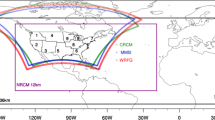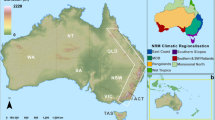Abstract
To determine the extent to which regional climate models (RCMs) preserve the large-scale atmospheric circulation of their driving fields, we investigate the ability of two RCM simulations to reproduce weather regimes over North America. Each RCM simulation is driven at its lateral boundaries by the ERA-Interim reanalysis, but one of them uses additional large-scale nudging (LSN) in the domain interior. Four weather regimes describing the variability of the large-scale atmospheric dynamics over North America are identified in winter and in summer. The analysis shows that for both seasons, the mean frequency of occurrence and persistence of the four weather regimes for the two RCM simulations are comparable to those of ERA-Interim. However, the frequency of false daily attributions of a specific regime on day-to-day and seasonal bases is significantly high, especially in summer, for the classic lateral-boundary driven simulation. Those false attributions are largely corrected with LSN. Using composite means for each weather regimes, substantial 2-m air temperature and precipitation anomalies associated to the large-scale atmospheric circulation are found. These anomalies are larger in winter than in summer. The validation of the simulations reveals that the 2-m air temperature bias is dependent on the weather regimes, especially in summer. Conversely, the precipitation bias varies significantly from one regime to another, especially in winter. Overall, the results suggest that a classic RCM simulates the mean statistics of the weather regimes well, but that LSN is necessary to reproduce daily weather regimes and seasonal anomalies that match with the driving field.

















Similar content being viewed by others
References
Alexandru A, de Elia R, Laprise R (2007) Internal variability in regional climate downscaling at the seasonal time scale. Mon Weather Rev 135:3221–3238. doi:10.1175/MWR3456.1
Alexandru A, de Elia R, Laprise R, Separovic L, Biner S (2009) Sensitivity study of regional climate model simulations to large-scale nudging parameters. Mon Weather Rev 137:1666–1686. doi:10.1175/2008MWR2620.1
Biner S, Caya D, Laprise R, Spacek L (2000) Nesting of RCMs by imposing large scales. In: Research activities in atmospheric and oceanic modelling, WMO = TD—No. 987, Report No. 30, pp 7.3–7.4
Bowden JH, Nolte CG, Otte TL (2013) Simulating the impact of the large-scale circulation on the 2-m temperature and precipitation climatology. Clim Dyn 40:1903–1920. doi:10.1007/s00382-012-1440-y
Bukovsky MS (2011) Masks for the Bukovsky regionalization of North America, Regional Integrated Sciences Collective, Institute for Mathematics Applied to Geosciences, National Center for Atmospheric Research, Boulder, CO. Downloaded 2014-08-25. http://www.narccap.ucar.edu/contrib/bukovsky/
Castro CL, Pielke RA Sr, Leoncini G (2005) Dynamical downscaling: assessment of value retained and added using the Regional Atmospheric Modeling System (RAMS). J Geophys Res 110:D05108. doi:10.1029/2004JD004721
Cattiaux J, Vautard R, Cassou C, Yiou P, Masson-Delmotte V, Codron F (2010) Winter 2010 in Europe: a cold extreme in a warming climate. Geophys Res Lett 37:L20704. doi:10.1029/2010GL044613
Cattiaux J, Douville H, Peings Y (2013) European temperatures in CMIP5: origins of present-day biases and future uncertainties. Clim Dyn 41:2889–2907. doi:10.1007/s00382-013-1731-y
Caya D, Biner S (2004) Internal variability of RCM simulations over an annual cycle. Clim Dyn 22:33–46. doi:10.1007/s00382-003-0360-2
Christensen OB, Gaertner MA, Prego JA, Polcher J (2001) Internal variability of regional climate models. Clim Dyn 17:875–887. doi:10.1007/s003820100154
Dee DP et al (2011) The ERA-Interim reanalysis: configuration and performance of the data assimilation system. Quart J R Meteorol Soc 137:553–597. doi:10.1002/qj.828
Diaconescu EP, Laprise R (2013) Can added value be expected in RCM-simulated large scales? Clim Dyn 41:1769–1800. doi:10.1007/s00382-012-1649-9
DiNapoli SM, Misra V (2012) Reconstructing the 20th century high-resolution climate of the southeastern United States. J Geophys Res 117:D19113. doi:10.1029/2012JD018303
Driouech F, Déqué M, Mokssit A (2009) Numerical simulation of the probability distribution function of precipitation over Morocco. Clim Dyn 32:1055–1063. doi:10.1007/s00382-008-0430-6
Giorgi F, Jones C, Asrar GR (2009) Addressing climate information needs at the regional level: the CORDEX framework. WMO Bull 58:175–183
Herrmann M, Somot S, Calmanti S, Dubois C, Sevault F (2011) Representation of spatial and temporal variability of daily wind speed and of intense wind events over the Mediterranean Sea using dynamical downscaling: impact of the regional climate model configuration. Nat Hazards Earth Syst Sci 11:1983–2001. doi:10.5194/nhess-11-1983-2011
Hong SY, Kanamitsu M (2014) Dynamical downscaling: fundamental issues from an NWP point of view and recommendations. Asia Pacific J Atmos Sci 50:83–104. doi:10.1007/s13143-014-0029-2
Hutchinson M, Mckenney DW, Lawrence K, Pedlar JH, Hopkinson RF, Milewska E, Papadopol P (2009) Development and testing of Canada-wide interpolated spatial models of daily minimum–maximum temperature and precipitation for 1961–2003. J Appl Meteorol Climatol 48:725–741. doi:10.1175/2008JAMC1979.1
Jones RG, Murphy JM, Noguer M (1995) Simulation of climate change over Europe using a nested regional-climate model. I: assessment of control climate, including sensitivity to location of lateral boundaries. Quart J R Meteorol Soc 121:1413–1449. doi:10.1002/qj.49712152610
Lucas-Picher P, Caya D, de Elia R, Laprise R (2008a) Investigation of regional climate models internal variability with a ten-member ensemble of ten-year simulations over a large domain. Clim Dyn 31:927–940. doi:10.1007/s00382-008-0384-8
Lucas-Picher P, Caya D, Biner S, Laprise R (2008b) Quantification of the lateral boundary forcing of a regional climate model using an ageing tracer. Mon Weather Rev 136:4980–4996. doi:10.1175/2008MWR2448.1
Lucas-Picher P, Somot S, Déqué M, Decharme B, Alias A (2013) Evaluation of the regional climate model ALADIN to simulate the climate over North America in the CORDEX framework. Clim Dyn 41:1117–1137. doi:10.1007/s00382-012-1613-8
Maurer EP, Wood AW, Adam JC, Lettenmaier DP, Nijssen B (2002) A long-term hydrologically-based dataset of land surface fluxes and states for the conterminous United States. J Clim 15:3237–3251. doi:10.1175/1520-0442(2002)015<3237:ALTHBD>2.0.CO;2
Mearns LO et al (2012) The North American regional climate change assessment program: overview of phase I results. Bull Am Meteorol Soc 93:1337–1362. doi:10.1175/BAMS-D-11-00223.1
Mesinger F et al (2006) North American regional reanalysis. Bull Am Meteorol Soc 87:343–360. doi:10.1175/BAMS-87-3-343
Miguez-Macho G, Stenchikov GL, Robock A (2004) Spectral nudging to eliminate the effects of domain position and geometry in regional climate model simulations. J Geophys Res 109:D13104. doi:10.1029/2003JD004495
Otte TL, Nolte CG, Otte MJ, Bowden JH (2012) Does nudging squelch the extremes in regional climate modeling? J Clim 25:7046–7066. doi:10.1175/JCLI-D-12-00048.1
Rinke A, Marbaix P, Dethloff K (2004) Internal variability in Arctic regional climate simulations: case study for the SHEBA year. Clim Res 27:197–209. doi:10.3354/cr027197
Roy P, Gachon P, Laprise R (2012) Assessment of summer extremes and climate variability over the north-east of North America as simulated by the Canadian Regional Climate Model. Int J Climatol 32:1615–1627. doi:10.1002/joc.2382
Rummukainen M (2010) State-of-the-art with regional climate models. Wiley Interdisciplinary Reviews. Clim Change 1:82–96. doi:10.1002/wcc.008
Sanchez-Gomez E, Somot S, Déqué M (2009) Ability of an ensemble of regional climate models to reproduce the weather regimes during the period 1961–2000. Clim Dyn 33:723–736. doi:10.1007/s00382-008-0502-7
Šeparović L, de Elía R, Laprise R (2012) Impact of spectral nudging and domain size in studies of RCM response to parameter modification. Clim Dyn 38:1325–1343. doi:10.1007/s00382-011-1072-7
Straus DM, Corti S, Molteni F (2007) Circulation regimes: chaotic variability versus SST-forced predictability. J Clim 20:2251–2272. doi:10.1175/JCLI4070.1
Vautard R et al (2013) The simulation of European heat waves from an ensemble of regional climate models within the EURO-CORDEX project. Clim Dyn 41:2555–2575. doi:10.1007/s00382-013-1714-z
Veljovic K, Rajkovic B, Fennessy MJ, Altshuler EL, Mesinger F (2010) Regional climate modeling: should one attempt improving on the large scales? Lateral boundary condition scheme: any impact? Meteorol Z 19:237–246. doi:10.1127/0941-2948/2010/0460
Voldoire A et al (2013) The CNRM-CM5.1 global climate model: description and basic evaluation. Clim Dyn 40:2091–2121. doi:10.1007/s00382-011-1259-y
von Storch H (2005) Models of global and regional climate. In: Anderson MG (ed) Encyclopedia of hydrological sciences, part 3. Meteorology and climatology, Chap 32, pp 478–490, ISBN: 0 471-49103-9. doi:10.1002/0470848944.hsa035
von Storch H, Langenberg H, Feser F (2000) A spectral nudging technique for dynamical downscaling purposes. Mon Weather Rev 128:3664–3673. doi:10.1175/1520-0493(2000)128<3664:ASNTFD>2.0.CO;2
Wang A, Zeng X (2013) Development of global hourly 0.5° land surface air temperature datasets. J Clim 26:7676–7691. doi:10.1175/JCLI-D-12-00682.1
Acknowledgments
This study was supported by a grant to the 1st author from the Fonds de recherche du Québec—Nature et technologies and a visiting scientist position at Météo-France, and by a subvention to the Canadian Network of Centres of Excellence (NCE) “Marine Environmental Observation, Prediction and Response” (MEOPAR).
Author information
Authors and Affiliations
Corresponding author
Rights and permissions
About this article
Cite this article
Lucas-Picher, P., Cattiaux, J., Bougie, A. et al. How does large-scale nudging in a regional climate model contribute to improving the simulation of weather regimes and seasonal extremes over North America?. Clim Dyn 46, 929–948 (2016). https://doi.org/10.1007/s00382-015-2623-0
Received:
Accepted:
Published:
Issue Date:
DOI: https://doi.org/10.1007/s00382-015-2623-0




